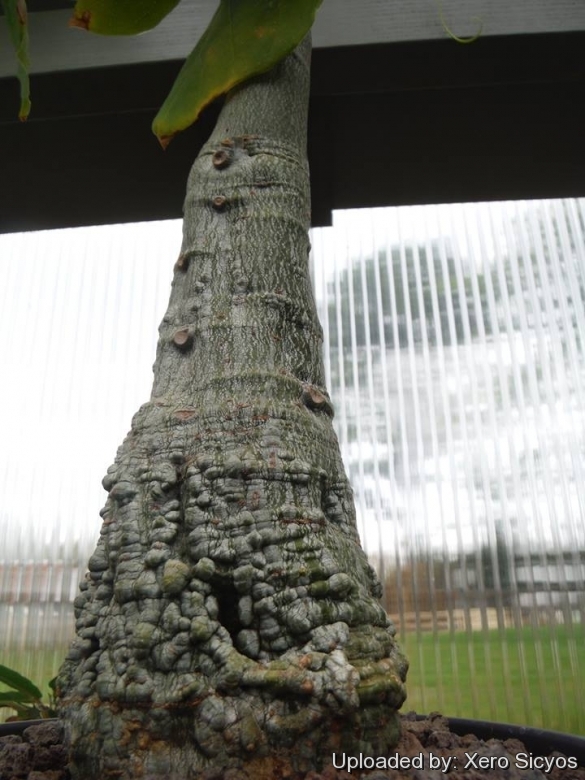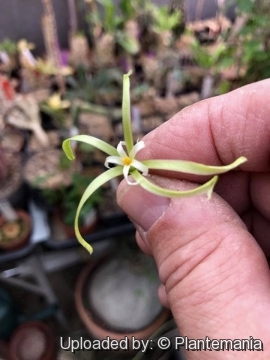
Adenia firingalavensis Photo by: Xero Sicyos
This species id easily identified by the dark dull green caudex which usually tapers upwards, but is occasionally spherical.
Origin and Habitat: Adenia firingalavensisSN|33281]]SN|33281]] is endemic to western and southern Madagascar. It is generally common, although with locally poor regeneration rates.
Altitude range: Ecology Adenia firingalarensis grows from sea level up to 500 metres above sea level.
Habitat and ecology: This species grows in sheltered places in shade of dry forest, scrub and rocky areas derived from limestone. Its flowers and fruits from August to December. This species is associated with Adenia firingalavensisSN|33281]]SN|33281]], Euphorbia viguieriSN|25966]]SN|25966]], Pachypodium rutenbergianumSN|14803]]SN|14816]], Pachypodium ambongenseSN|14816]]SN|14803]], and Xerosicyos perrieri.
Synonyms:
Common Names include:
ENGLISH: Bottle liana
Description: Adenia firingalavensisSN|33281]]SN|33281]] is a slow growing large, deciduous, succulent liana up to 15 m long with a conical warty waxy bottle-shaped trunk also known as a caudex. It climbs by means of tendrils, the inflorescence is axillary. The fruit is an ovoid capsule.
Stem: Swollen caudiciform base of the stem (bole) conical to subspherical, up to 2 m tall and 50 cm in diameter. Outer blue-green for photosynthesis throughout the dry season, warty and mostly covered with a thick greenish waxy or resinous layer (It sometimes lacks a caudex when growing on more humid, deep soil, suggesting that the harsh conditions of may contribute to caudex formation as a survival mechanism.) Branches vine-like, up to 3.5 ( or more) m long and 1.5-3 mm thick.
Leaves: Short-lived, simple. Petiole 2-10(-12) cm long, with 2 glands at apex. Blade (lamina) brownish green above, grey or glaucous beneath orbicular to ovate, entire to 3(-5)-lobed, 3-10(-17) cm 0 2.5-10(-18) cm, base cordate, apex acuminate, margin entire, venal reticulation distinct. The axils bearing a tendril or an inflorescence. Stipules triangular to filiform, up to 1 mm long.
Tendrils: Simple, 4-10 cm long.
Inflorescence: Axillary on short shoots or peduncled, bearing 1-5 male flowers or 1(-2) female flowers. Sometimes plants monoecious.
Male flowers: Funnel-shaped, up to about 3 cm long. Sepals 5, linear, 9-30 mm long and 1-2 mm wide. Petals 5, lanceolate-linear, 6-16 mm long, 1-2 mm wide. Stamens 5, filaments 4-9 mm long, base connate, anthers 5 mm long. Corona inconspicuous or absent. Rudimentary ovary present.
Female flowers: Broadly funnel-shaped, up to about 40 mm long and 5 mm in diameter. Sepals narrowly lanceolate to linear, up to 30 mm long. Petals lanceolate to linear, up to 20 mm long, 2.5 mm wide. Staminodes 5, linear. Corona inconspicuous or absent; ovary ovoid-oblong, 4-8 mm long, 6-ribbed, styles 3, stigmas somewhat kidney-shaped.
Fruit (capsule): Ovoid, solitary, 6-7 cm long 3-4 cm in diameter, 1-celled. Skin (pericarp) leathery, opening with 3 valves, 30-60-seeded.
Seed: Ovoid to globose, flattened, 6-8 mm by 5-7 mm.
Similar species: Adenia stylosaSN|28284]]SN|28282]] (Perr.) D.J.Hearn (synonym: Adenia firingalavensis var. stylosaSN|28282]]SN|28284]] (H.Perrier) W.J.de Wilde) from northern Madagascar resembles Adenia firingalavensisSN|33281]]SN|33281]], but is a separate species.
Bibliography: Major references and further lectures
1) Urs Eggli “Illustrated Handbook of Succulent Plants: Dicotyledons” Springer Science & Business Media, 2002
2) Brink, M. & Achigan-Dako, E.G. “Fibres” PROTA, 2012
3) Umberto Quattrocchi “CRC World Dictionary of Medicinal and Poisonous Plants: Common Names, Scientific Names, Eponyms, Synonyms, and Etymology” (5 Volume Set)
CRC Press, 19 April 2016
4) Werner Rauh, Herman Schwartz “Succulent and xerophytic plants of Madagascar”, Volume 2 Strawberry Press, 1998
5) S. H. J. V. Rapanarivo “Pachypodium (Apocynaceae)” CRC Press, 01 June 1999
6) Hilary Bradt, Daniel Austin “Madagascar” Bradt Travel Guides, 01 July 2014
 Adenia firingalavensis (Male flower) Photo by: © Plantemania
Adenia firingalavensis (Male flower) Photo by: © PlantemaniaSend a photo of this plant.The gallery now contains thousands of pictures, however it is possible to do even more. We are, of course, seeking photos of species not yet shown in the gallery but not only that, we are also looking for better pictures than those already present.
Read More... Cultivation and Propagation: In spite of its large size and slow growth Adenia Adenia epigea is grown by specialist collectors of succulents but on a small scale only. It is an excellent pot plant and it should make an interesting addition to a collection. It can be grown outdoors in frost-free climates and forms an impenetrable shrub if not manicured.
Growth rate: It grows well, though very slowly, but it possible to increase the speed of growth to some extent by providing adequate amount of water, warmth, and fertilizer during the active growing season, but it’s susceptible to rotting if too wet.
Exposure: It needs light shade, but the caudex should be in the shade, while the leaves prefer some sun. Avoid direct blasting sun in summer. Bright light if grown indoors.
Soil: It needs a very porous potting medium (add pumice, vulcanite, and perlite). It does better in a rather acidic soil.
Waterings: Water frequently while plant is in full growth, but keep dry during the winter after the branches have died back. It rot easily and do NOT like a lot of water when it has no leaves.
Fertilizer: Benefits from moderate doses of a well-balanced, slow-release fertilizer.
Frost tolerance: Due to its African origin keep warm in winter, the minimum safe average temperature is 15°C, although it can go lower for short periods. It can be grown outdoors in frost-free climates, need anyway to kept above 10°C and dry in winter. It is very prone to rot in cool, wet conditions. USDA Zone 12, but does very well in containers.
Maintenance: Repot every two years. It like pots with generous drain holes. In the winter, the vining branches die back and should be cut back to encourage branching, to maintain an attractive shape and to ensure caudex habit. If pruned and kept somewhat pot bound, it can be maintained at a manageable size, depending on what ''manageable size'' means to you.
Propagation: Propagation is possible by seed or cuttings. The plants for seed production are generally grown from cuttings since these bloom more freely. The plants for decoration are grown from seed since they develop a caudex.
Warning: As with all Adenias, all parts of this plant are very toxic, and they should be handled with caution, particularly when pruning.












